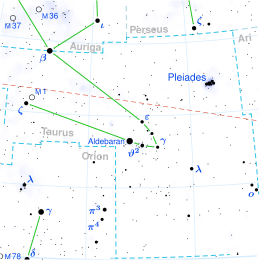HD 28375 is a single[10] star in the equatorial constellation of Taurus, near the southern constellation border with Eridanus. It was previously known by the Flamsteed designation 44 Eridani, although the name has fallen out of use because constellations were redrawn, placing the star out of Eridanus and into Taurus. The star is blue-white in hue and is dimly visible to the naked eye with an apparent visual magnitude of 5.53.[2] The distance to this star is approximately 480 light-years based on parallax.[1] It is drifting further away with a radial velocity of 18 km/s,[5] after having come to within an estimated 249 light-years some 3.7 million years ago.[2]
| Observation data Epoch J2000 Equinox J2000 | |
|---|---|
| Constellation | Taurus |
| Right ascension | 04h 28m 32.12178s[1] |
| Declination | +01° 22′ 50.9687″[1] |
| Apparent magnitude (V) | 5.53[2] |
| Characteristics | |
| Spectral type | B3V[3] |
| U−B color index | -0.55[4] |
| B−V color index | −0.099±0.008[2] |
| Astrometry | |
| Radial velocity (Rv) | 18.0±4.3[5] km/s |
| Proper motion (μ) | RA: +19.530[1] mas/yr Dec.: −20.272[1] mas/yr |
| Parallax (π) | 6.8102 ± 0.1690 mas[1] |
| Distance | 480 ± 10 ly (147 ± 4 pc) |
| Absolute magnitude (MV) | 0.19[2] |
| Details | |
| Mass | 5.0±0.1[6] M☉ |
| Luminosity | 126.75[2] L☉ |
| Surface gravity (log g) | 4[3] cgs |
| Temperature | 13,000[3] K |
| Metallicity [Fe/H] | 0.05±0.06[7] dex |
| Rotational velocity (v sin i) | 13±3[8] km/s |
| Age | 3.1±2.1[6] Myr |
| Other designations | |
| Database references | |
| SIMBAD | data |
Cowley (1972) and later Bragança et al. (2012) found a stellar classification of B3V[11][12] for this object, matching a B-type main-sequence star. Houk and Swift assigned it a class of B5 III/IV,[13] suggesting it is a more evolved star that is entering the giant stage. It has five times the mass of the Sun and is around three million years old,[6] with a projected rotational velocity of just 13 km/s.[8] The star is radiating 127[2] times the luminosity of the Sun from its photosphere at an effective temperature of about 13,000 K.[3]
An infrared excess has been detected, indicating the presence of a circumstellar disk. The dust has a temperature of about 119 K and is orbiting 67 AU from the star.[3]
